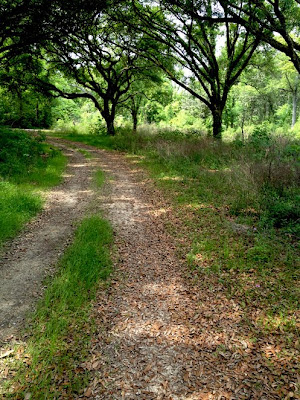
The fact of having grown up in this or that city is oftentimes weak support for the returnee finding his way through the post-childhood development that ravages the landscape of memory. We tell ourselves that we know this, remember that, but when conjecture comes face to face with a street grid, many of our suppositions crumble like a house of cards. But in fact, the falling house of cards on Monday wasn’t a matter of badly remembered streets, but one of walking on ground once thick with forest growth and wetland, a place Daniel Boone might have charged into, but one most of the non-pioneer types stayed out of. But then a lot can happen in fifty-two years over which new streets and highways rise out of dirt and neighborhoods evolve to tweak a city impatient for growth.

Back in the days when the only Elvis around was not named Costello the area of Baton Rouge bordering Jefferson Highway in the southeast was woodland waiting for the developer’s axe. One or two connecting roads cut through the green, but it was land earmarked for a future we couldn’t yet see. A large tract of the land belonged to the Ollie Steele Burden family and was in the 1880s site of Windrush Plantation. At the time of his death in 1995, Steele Burden bequeathed the land to Louisiana State University with a stipulation that it be used for agricultural and horticultural research with minimal development otherwise.

Today this large tract of 440 acres is home to the Burden Center-LSU Agcenter. In addition to research plots devoted to agriculture, the property includes a rose garden, camellia garden, five miles of walking trails, the Windrush Gardens, the Rural Life Museum and grounds offering a look at plantation life in the nineteenth century. Unmentioned in the center’s brochure is a meditation garden, one focused solely on a lotus-filled pond.

For the past several days walking has been confined to Sevenoaks Avenue, but hearing about the Burden Center’s nature trails widened my options. An easy drive from Old Goodwood and I found everything exactly as described, with plenty of parking. The several nature trails branch off from a spot very near the parking area and within minutes the chosen path is wrapped in wall-to-wall green. But the first yards of walking are confused by the sound of cars on I-10 just off the eastern edge of the Burden acreage. Apart from sky every corner of the walker’s view is enclosed in a rumpled green blanket sprinkled with wildflowers, and over the wall of green comes the whoosh of high speed traffic headed for New Orleans. Walk around the next curve in the trail and there through a thin mesh of trees are the cars skimming over the unseen interstate, and then just as quickly lost again around the next clump of swamp cabbage. And in the next moment a long-lost earthy musk of Louisiana rises to my face.

Lost in the middle of all this protected land, somewhere off the marked trails and wandering a crushed shell road, I came upon a scatter of gargantuan iron cogs and wheels, a thrown down sculpture of giant parts from an archaic industry. The road passed along an assembly of old wooden buildings behind split rail fencing, and thinking it unremarkable I ducked between the fence rails to have a look. Two people, standing nearby and startled, told me the gate was off thataway, at the rear of the Rural Life Museum and that I had saved $6.00 by coming in the back way. To mark my savings I took a photo of the “old slave” statue just in front of my secret entrance. Despite the lack of a blue visitor’s tag no one bothered me as I walked about the church and slave quarters of the old Windrush Plantation, but I didn’t push my luck by venturing too near the museum.

Not five minutes after crawling back out the split rails and once again on a marked trail, payback came in the form of a sudden downpour. Too much rain and too much distance made it clear getting wet was the only way back. Back in the car my glasses were running and my shirt sopping, but my pedometer showed almost four miles of walking. Enough to make wetness a secondary concern at the end of a happy day.

Trailing off into green along the Palmetto Trail

Beautiful, an evocative post--especially the first line. Again, sights seen and described by a post-childhood returnee makes for appreciation of landscapes too often hurried by and not explored very often by permanent residents. And part of the allure of Louisiana are those pockets of visible history amid the hustle and bustle of interstate life.
ReplyDeleteYou made me homesick for the Swamp.
ReplyDeleteI'm sure you were in heaven walking down those paths. The rain simply brought a refreshment to the end of the day.
ReplyDeleteFreedomPop is the #1 ABSOLUTELY FREE mobile phone provider.
ReplyDeleteVoice, SMS & data plans starting at £0.00/month (ABSOLUTELY FREE).